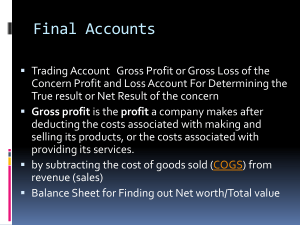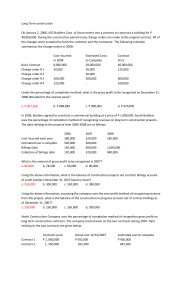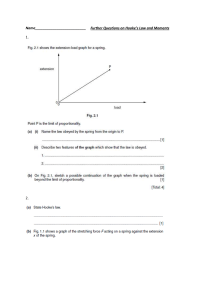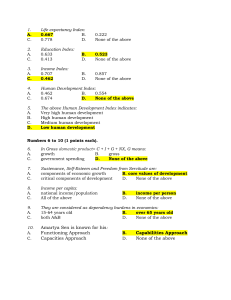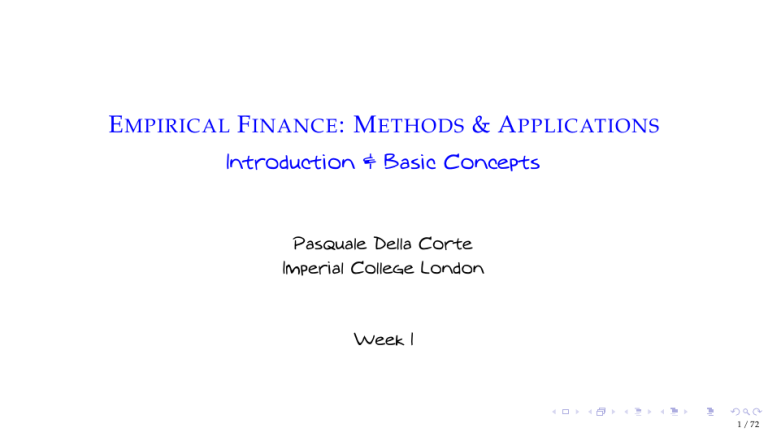
E MPIRICAL F INANCE : M ETHODS & A PPLICATIONS
Introduction & Basic Concepts
Pasquale Della Corte
Imperial College London
Week 1
1 / 72
Introduction
Why are empirical methods for finance (and economics more in general) important?
“Theorists develop models with testable predictions; empirical researchers document ‘puzzles’ – stylized facts that fail to fit established theories – and this stimulates the development of new theories.
Such a process is part of the normal development of any science. Asset pricing, like the rest of economics, faces the special challenge that data are generated naturally rather than experimentally, and so
researchers cannot control the quantity of data or the random shocks that affect the data.”
John Y. Campbell (2000). Asset Pricing at the Millemium, Journal of Finance.
2 / 72
Introduction
But economics is not an experimental science and we face difficult problems of inference.
“The economic world is extremely complicated. There are millions of people and firms, thousands
of prices and industries.
One possible way of figuring out economic laws in such a setting is by controlled experiments ... like those done by chemists, physicists, and biologists ...
Economists have no such luxury when testing economic laws. They cannot perform the controlled experiments of chemists or biologists because they cannot easily control other important factors. Just like
astronomers or meteorologists, they usually have to solely use their observation.”
Paul Samuelson & William Nordhaus (1985). Economics, McGraw Hill.
3 / 72
Simple (or Discrete) Returns
4 / 72
What is an Asset Return?
The return of an asset is an important concept of modern finance
It is the benefit that an investor receives for holding an asset,
It depends on the holding period of the asset (e.g., one day, one month, etc).
To calculate an asset return, we need the price of the asset
Price are formed in different markets: auction markets, dealer markets, etc.
We may observe transaction prices, indicative quotes, or effective quotes.
5 / 72
Simple Return: One Period
Let Pt be the price of an asset that pays no dividends at time t
Suppose you hold the asset for a single period, meaning between times t and t + 1,
Start from simple (or discrete) returns as prices are observed at some discrete intervals.
The simple gross return between times t and t + 1 is calculated as
Why t+ 1 rather than t?
I could have also
Pt +1
R
=
t
+
1
Because the return is
written Rt,t+ 1
Pt
known ex-post at t+ 1
The simple net return (or simple return) between times t and t + 1 is calculated as
I could have also
written rt,t+ 1
rt +1 =
Pt + 1
−1
Pt
1+r=R
6 / 72
Simple Return: Two Periods
The simple gross return between times t and t + 2 is calculated as
Rt,t +2 =
Pt +2
Pt +2
Pt +1
=
×
Pt
Pt +1
Pt
one-period gross
return Rt+ 1, t+ 2
one-period gross
return Rt,t+ 1
The simple gross return between times t and t + 2 can be written (drop the first subscript) as
Rt,t +2 = Rt +2 × Rt +1
7 / 72
Simple Return: Two Periods
The simple net return between times t and t + 2 is then obtained as
rt,t +2 = (Rt +2 × Rt +1 ) − 1
rewrite R = 1 + r
= (1 + rt +2 ) × (1 + rt +1 ) − 1
Recall that for ε and ζ near to zero (‘small’)
(1 + ε)(1 + ζ ) ≈ 1 + ε + ζ
we drop the term ζε
If returns are small, the simple net return between times t and t + 2 can be written as
rt,t +2 ≈ rt +2 + rt +1
8 / 72
Simple Return: Multi Periods
The simple gross return between times t and t + k is calculated as
Rt,t +k =
one-period gross
return Rt+k- 1, t+ k
Pt +k
Pt +k
P
Pt +1
=
× t +k −1 × . . . ×
Pt
Pt +k −1
Pt +k −2
Pt
one-period gross
return Rt+ 1
one-period gross
return Rt+k- 1,t+k- 2
The simple gross return between times t and t + k can be written (drop the first subscript) as
k
Rt,t +k = Rt +k × Rt +k −1 × . . . × Rt +1 =
∏ Rt + j
j =1
9 / 72
Simple Return: Multi Periods
The simple net return between times t and t + 2 is then obtained as
rt,t +k =
k
∏ Rt + j
−1
j =1
rewrite R = 1 + r
=
k
∏ (1 + rt +j )
−1
j =1
If returns are small, the simple net return between times t and t + k can be written as
k
rt,t +k ≈
∑ rt +j
j =1
Approximately, the multi-period discrete return is the sum of one-period discrete returns.
10 / 72
Average Simple Returns
What is the average return if you hold an asset over multiple periods?
For example, you want to compare assets held over different periods.
The average simple gross return can be computed as follows
k
∏R =
j =1
k
∏ Rt + j
j =1
one-period constant return
one-period actual return
The left-hand side can be simplified so that
k
R =
k
∏ Rt + j
j =1
R and Rt should deliver an identical payoff over the same holding period.
11 / 72
Average Simple Returns
The average simple gross return is thus given by
R=
k
∏ Rt + j
1/k
Geometric Average
j =1
The average simple net return follows as
r =
k
∏ Rt + j
1/k
−1
j =1
If returns are small, the average simple net return is approximately
r ≈
1
k
k
∑ rt +j
Arithmetic Average
j =1
12 / 72
Simple Returns: Dividend Payment
If there is a dividend payment, the one-period simple gross return is calculated as follows
Rt + 1 =
Pt +1 + Dt +1
Pt
Dividend Payment
We can also decompose the gross return as follows
Rt + 1 =
Capital Gain
Pt +1
Dt + 1
+
Pt
Pt
Dividend Yield
In practice, dealing with dividend payments is quite complicated as they are paid infrequently.
We typically rely on the data provider to make available prices adjusted for dividends.
13 / 72
Simple Returns: Dividend Payment
14 / 72
Simple Returns in Real Terms
In some cases, we need the performance of an asset after accounting for inflation
For example, there are different inflation regimes when using long-span data.
The real simple gross return is calculated as follows
Rtr+1 =
or
Rtr+1 =
Pt +1 /CPIt +1
Pt /CPIt
Consumer Price
Index at time t
Pt +1
CPIt
×
Pt
CPIt +1
Consumer Price
Index at time t+ 1
15 / 72
Simple Returns in Real Terms
(1 + π t +1 ) −1
Let’s dig a bit more into it as follows
Rtr+1 =
Pt +1
CPIt
×
Pt
CPIt +1
Inverse of gross
inflation rate
Let πt +1 be the inflation rate between t and t + 1 and rewrite as
rtr+1 =
1 + rt +1
rt +1 − πt +1
−1 =
1 + π t +1
1 + π t +1
If πt +1 is reasonable small, we have that
rtr+1 ≈ rt +1 − πt +1
16 / 72
Simple Riskless Return
The riskless return is the return on an investment with no risk
It is a theoretical quantity that does not exists,
We often use short-term government bond rate with almost no risk of default as a proxy.
Which proxy then?
The US Treasury Bill (or simply T-Bill) rate is an example of short-term riskless rate
The German Federal Treasury rate is another example of short-term riskless rate.
One-month and three-month maturity instruments are generally used.
17 / 72
Simple Riskless Return
Let Bt be the price of a short-term government bond at time t
A zero-coupon bond that expires after one period (e.g., one month),
The liquidation price at time t + 1 is known at time t.
The simple gross riskless rate between times t and t + 1 is calculated as
I could have also
Why t rather than t+ 1?
Bt +1
Rtf =
written Rft,t+ 1
Because the return is
Bt
known ex-ante at t
The simple net riskless rate between times t and t + 1 is calculated as
I could have also
Bt +1
rtf =
−1
written rft,t+ 1
1 + rf = Rf
Bt
18 / 72
Simple Excess Return
The simple excess return between times t and t + 1 is calculated as
Rte+1 = Rt +1 − Rtf
or alternatively as
rte+1 = rt +1 − rtf
Rt+ 1 and Rft are both
defined over the same
investment horizon
ret+ 1 = Ret+ 1
The excess return is always a net return, no matter if you use gross or net returns.
19 / 72
Simple Portfolio Return
Consider n assets and hold them for a single period (i = 1, 2, . . . , n)
Pi,t is the price of the asset i,
Qi is the number of the asset i.
The value of the portfolio at time t is
Vt = Q1 P1,t + Q2 P2,t + . . . + Qn Pn,t
The portfolio weight of asset i at time t is
wi,t =
Qi Pi,t
Vt
20 / 72
Simple Portfolio Return
The value of the portfolio at time t + 1 is
Vt +1 = Q1 P1,t +1 + Q2 P2,t +1 + . . . + Qn Pn,t +1
Replace
Qi = Vt
wi,t
Pi,t
Rewrite as
Vt +1 =
w1,t Vt P1,t +1
w2,t Vt P2,t +1
wn,t Vt Pn,t +1
+
+...+
P1,t
P2,t
Pn,t
= Vt (w1,t R1,t +1 + w2,t R2,t +1 + . . . + wn,t Rn,t +1 )
21 / 72
Simple Portfolio Return
The simple portfolio return at time t + 1 is given by
Rtp+1 =
Vt +1
Vt
= w1,t R1,t +1 + w2,t R2,t +1 + . . . + wn,t Rn,t +1
Simple returns have the property of portfolio additivity since
Rtp+1 =
n
∑ wi,t Ri,t +1
i =1
22 / 72
Log (or Continuously Compounded) Returns
23 / 72
Log Returns: One Period
Simple returns are calculated over a given interval
Suppose you have an investment horizon of a single day,
Buy the asset at time t (today) and sell it at time t + 1 (tomorrow).
You realize the interest rate after a day and calculate it as
Pt +1
= (1 + rt +1 )
Pt
Suppose the interest rate is now paid over m sub-interval m (e.g., every hour)
Pt +1
rt +1 m
= 1+
Pt
m
24 / 72
Log Returns: One Period
If the interest rate is cumulated continuously (m → ∞), we have
m
Pt + 1
rt +1
= lim 1 +
m→∞
Pt
m
= e rt + 1
The one-period log return between times t and t + 1 is thus given by
rt +1 = ln(Pt +1 ) − ln(Pt )
or alternatively from gross discrete returns
rt +1 = ln(Rt +1 )
Warning: to avoid additional notation, I have used the same notation to indicate both net gross
and log returns, but they are not identical.
25 / 72
Log Returns: Two Periods
The log return between times t and t + 2 is calculated as
Pt +2
Pt +2
Pt +1
= ln
rt,t +2 = ln
×
Pt
Pt +1
Pt
one-period gross
return Rt+ 2
one-period gross
return Rt+ 1
The log return between times t and t + 2 can be then written as
rt,t +2 = ln(Rt +2 ) + ln(Rt +1 )
the sum of one-period gross returns in log terms.
26 / 72
Log Returns: Multi Periods
The log return between times t and t + k is calculated as
Pt + k
Pt +k
Pt +k −1
Pt +1
= ln
rt,t +k = ln
×
×...×
Pt
Pt +k −1
Pt +k −2
Pt
one-period gross
return Rt+ k
one-period gross
return Rt+k- 1
one-period gros
return Rt,t+ 1
The log return between times t and t + k can be then written as
k
rt,t +k =
∑ ln(Rt +i )
i =1
the sum of one-period gross returns in log terms.
27 / 72
Average Log Returns
The average log return between times t and t + k can be then written as
r =
1
k
k
∑ ln(Rt +i )
i =1
the average of one-period gross returns in log terms being them time additive.
28 / 72
Log Returns: Other Definitions
The one-period log return between times t and t + 1 with a dividend payment is
Pt +1 + Dt +1
rt +1 = ln
Pt
= ln Pt +1 + Dt +1 − ln Pt
The one-period log return between times t and t + 1 in real terms
CPIt
Pt +1
×
rtr+1 = ln
Pt
CPIt +1
Pt +1
CPIt +1
= ln
− ln
Pt
CPIt
= rt +1 − πt +1
29 / 72
Log Returns: Other Definitions
The one-period log excess return between times t and t + 1 is
rte+1 = ln(Rt +1 ) − ln(Rtf )
or alternatively as
rte+1 = rt +1 − rtf
Different from
ln(Rt+ 1 - Rft )
This is the log
riskless return
The portfolio log excess return between times t and t + 1 is calculated as
rtp+1 = ln(Rtp+1 ) = ln (∑ni=1 wi,t Ri,t +1 ) ̸= (∑ni=1 wi ri,t +1 )
Log of weighted average
simple gross returns
weighted average
of log returns
30 / 72
Log Returns: Other Definitions
When returns are small (’measured over short time intervals’)
!
rtp+1 ≈
n
∑ wi ri,t +1
i =1
When do we use log returns? For time-series analysis to limit the impact of large outliers.
31 / 72
Simple vs Log Returns
32 / 72
Stylized Facts
33 / 72
Stylized Facts
Empirical studies have identified several stylized facts among financial data
1. Fat Tails
The unconditional distribution of returns displays fatter tails than the normal distribution.
By using a normal distribution to model financial returns, we underestimate both the number
and the magnitude of crashes and booms.
2. Asymmetry
The unconditional distribution is negatively skewed suggesting that extreme negative returns
are more frequent than extreme positive returns. The asymmetry and the fat-tails persists
even after adjusting for conditional heteroskedasticity. This means that the conditional
distribution is also non-normal.
34 / 72
Stylized Facts
3. Aggregate Normality
As the frequency of the returns diminishes, the distribution of financial returns approaches
the normal distribution.
4. Absence of Serial Correlation
Financial returns display little or no serial correlations, except at high frequency.
5. Volatility Clustering
Volatility of returns is serially correlated, suggesting that a large positive (negative) return
tends to be followed by another large positive (negative) return.
6. Time-varying Correlations
Correlations between asset returns tends to increase during high-volatility periods, in particular during crashes.
35 / 72
Moments
Let X be a continuous random variable
The probability density function (pdf ) of X is a nonnegative function f (x ) such that for
any interval [a, b ]
Pr (a ≤ X ≤ b ) =
Z b
f (x )dx
a
where Pr (·) is the area under the probability curve over the interval [a, b ]
The pdf f (x ) must satisfy
Z ∞
−∞
f (x )dx = 1
36 / 72
Moments
The cumulative density function (cdf ) of X is defined as
F (x ) = Pr (X ≤ x ) =
Z x
−∞
f (u )du
and satisfies the following properties
1. the cdf is non-negative: F (x ) ≥ 0,
2. the cdf goes to zero on the far left: limx →−∞ F (x ) = 0,
3. the cdf goes to one on the far right: limx →∞ F (x ) = 1,
37 / 72
Moments
4. the cdf is non-decreasing: F (b ) ≥ F (a ) if b ≥ a. If b ≥ a, then X ≤ a is a sub-set of
X ≤ b, and sub-sets never have higher probabilities,
5. Pr (X ≥ x ) = 1 − F (x ),
6. Pr (x1 ≤ X ≤ x2 ) = F (x2 ) − F (x1 ),
7.
d
dx F (x )
= f (x ).
38 / 72
Moments
The k th uncentered moment of X is defined as
Z
mk = E X k =
∞
−∞
x k f (x )dx
where k is an integer.
The k th centered moment of X is defined as
Z
µk = E (X − m1 )k =
∞
−∞
(x − m1 )k f (x )dx
where m1 = E X is the first uncentered moment.
39 / 72
Moments
Uncentered and centered moments (if they exist) are related via the binomial transformation as
k
µk =
∑ (−1)k −i
i =0
k
mi m1k −i
i
40 / 72
Moments
To sum up, we have the following
µ1 = 0
µ2 = m2 − m12
µ3 = m3 − 3m2 m1 + 2m13
µ4 = m4 − 4m3 m1 + 6m2 m12 − 3m14
where
µ1
zero by construction
µ2
this is the variance
µ3
non-standardized skewness
µ4
non-standardized kurtosis
41 / 72
Moments
The mean is the first non-centered moment
µ = E X = m1
and an indicator of central tendency.
The variance is the second centered moment
σ2 = V X = m2 − m12
and an indicator of dispersion around µ.
42 / 72
Moments
The skewness is the standardized third centered moment
3 X −µ
sk = SK X = E
σ
and an indicator of symmetry.
The kurtosis is the standardized fourth centered moment
4 X −µ
ku = KU X = E
σ
and an indicator of tail heaviness.
43 / 72
Empirical Moments
How do practically estimate the moments?
Let {x1 , . . . , xT } be a random sample from X with T observations.
The sample mean is
b=
µ
1
T
T
∑ xt ,
i =1
The sample variance is
b
σ2 =
T
1
(xt − µb)2
T − 1 i∑
=1
44 / 72
Empirical Moments
The sample skewness is
b
s=
T
1
(xt − µb)3
∑
b
σ3
T − 1 i =1
κb =
T
1
(xt − µb)4
∑
b
T − 1 i =1
σ4
The sample kurtosis is
45 / 72
Empirical Moments
Kendall & Stuart (1977) derive the following asymptotic distributions under normality
√
√
a
N(0, σ2 )
a
N(0, 2σ4 )
b − µ)
T (µ
⇒
T (b
σ2 − σ2 )
√
Tb
s
√
T (κb − 3)
⇒
a
⇒
a
⇒
N(0, 6)
N(0, 24)
a
where ⇒ denotes asymptotic convergence. Note that since the asymptotic variances are large,
sample skewness and sample kurtosis are only informative for large samples.
46 / 72
Testing for Normality
Jarque & Bera (1987) show that under the null of normality (s = 0 and κ − 3 = 0)
JB =
b
s2
(κb − 3)2 a 2
+
∽ χ (2)
6/T
24/T
where χ2(2) is a chi-square with two degree of freedom.
This test combines
√
b
s
a
∽ N(0, 1)
6/T
κb − 3 a
√
∽ N(0, 1)
24/T
knowing that the sum of two normals delivers a chi-square distribution.
47 / 72
Testing for Normality
The Jarque & Bera (1987) test presents a number of drawbacks
the asymptotic distribution only holds for large samples
b
s and κb are computed for given values of mean and variance,
b
s and κb are both subject to sampling errors.
48 / 72
Empirical Moments
Fat tails and asymmetry are key aspects of financial time series
Normality is often rejected because of high kurtosis: Extreme values are more likely than
what the normal distribution implies (leptokurtic distribution),
A mismatch between the unconditional mean and mode: A tail is longer than the other
(skewed distribution),
Negative skewness: the mean is at the left of the mode or the left tail is longer (left-skewed
distribution),
Positive skewness: the mean is at the right of the mode or the right tail is longer (rightskewed distribution).
49 / 72
Fat Tails
The Student’s t-distribution is widely used in finance to accommodate excess kurtosis
Y is a random variable from a t-distribution with location parameter 0, scale parameter 1,
and the degree of freedom ν
ν
Y ∼ t 0,
,ν
ν−2
The density of Y is given by
1
Γ ( ν+
2 )
f (y | ν ) =
ν
Γ( 2 )(πν)1/2
y2
1+
ν
− ν+2 1
The distribution has fat tails when ν is small
we have a Cauchy distribution when ν = 1,
we approach a Normal distribution when ν > 30.
50 / 72
Fat Tails
The key moments of a t-distribution
E (Y ) = 0
V (Y ) =
for ν > 1
ν
ν−2
Sk (Y ) = 0
Ku (Y ) = 3 +
for ν > 2
for ν > 3
6
ν−4
for ν > 4
51 / 72
Fat Tails
How do we sample from a t-distribution?
x ∼ N (0, 1)
s ∼ χ2(ν)
x
y = ps
ν
y ∼ t 0,
ν
,ν
ν−2
For empirical applications, it is convenient to redefine the t-distribution so to have unit variance.
52 / 72
Standardized Distributions
53 / 72
Transformation of Random Variables
Let X be a random variable with a given density
fX (x )
Define a new random variable Y
Y = g (X )
The density of Y is obtained via the density function method
fY (y ) =
d −1
g (y ) fx (g −1 (y ))
dy
54 / 72
Transformation of Random Variables
As an example, let X ∼ N (0, 1) and define
Y = µ + σX
We can now compute the density of Y as follows
d y −µ
y −µ
fY (y ) =
fX
dy
σ
σ
=
2 1 1
1 y −µ
√ exp −
σ 2π
2
σ
55 / 72
Transformation of Random Variables
We can use the same trick to have a t-student with unit variance
If X has a t-distribution, we aim at Y with a standardized t-distribution.
Let X have the following distribution
X ∼ t 0,
and then define Y as
ν
,ν
ν−2
X
Y = q
ν
ν −2
56 / 72
Transformation of Random Variables
The density of Y is then computed as
r
r
d
ν
ν
fY (y ) =
y
fX y
dy
ν−2
ν−2
r
=
=
r
2 − ν+2 1
1
Γ ( ν+
ν
ν
1
2 )
1+ y
ν
1/2
ν − 2 Γ( 2 )(πν)
ν−2 ν
1
Γ ( ν+
2 )
Γ( 2ν )(π (ν − 2))1/2
y2
1+
ν−2
− ν+2 1
fY (y ) is the density of a t-distribution with zero mean, unit variance, and dof ν > 2.
57 / 72
Fat Tails
Let Y be a random variable from a t-distribution with zero mean, unit variance, and dof ν.
Y ∼ t (0, 1, ν)
Its density is described by
1
Γ ( ν+
2 )
f (y | ν ) =
Γ( 2ν )(π (ν − 2))1/2
y2
1+
ν−2
− ν+2 1
with (otherwise undefined)
ν>2
58 / 72
Fat Tails
The key moments are
Sk (Y ) = 0
Ku (Y ) = 3
for
ν−2
ν−4
ν>3
for
ν>4
Sampling
ν
, ν)
ν−2
r
ν
y = x/
ν−2
x ∼ t (0,
y ∼ t (0, 1, ν)
59 / 72
Fat Tails and Asymmetry
To accommodate both excess kurtosis and skewness, Hansen (1994) proposed a skewed Student
distribution by combining a Student distribution with the asymmetry coefficient λ
Although this density is quite easy to implement, he did not discuss the relation between λ
and higher moments.
More recently, Fernandéz and Steel (1998) have developed a skewed t-distribution which has the
advantage that all the parameters have a clear interpretation
They introduce skewness in any univariate pdf g (·), which is unimodal and symmetric
around 0, by changing the scale at each side of the mode.
60 / 72
Fat Tails and Asymmetry
Start from a symmetric distribution with zero mean and unit variance
X ∼ g (0, 1)
Define a Bernoulli random variable with probability of success ξ 2 /(1 + ξ 2 ) as
W ∼ B ξ 2 / (1 + ξ 2 )
Consider the following mixture
1
Y = W ξ |X | − (1 − W ) |X |
ξ
61 / 72
Fat Tails and Asymmetry
We have a class of skewed unimodal distributions indexed by skewness parameter
ξ ∈ (0, ∞)
The density of this new distribution is defined as
f (y | ξ ) =
where
(
I=
2
g (y ξ I )
ξ + 1ξ
−1 if
1 if
y ≥0
y <0
62 / 72
Fat Tails and Asymmetry
What happens?
When y is positive, we divide y by a positive constant ξ.
When y is negative, we multiply y by a positive constant ξ,
f (y |ξ ) maintains the same mode at 0 as g (y ) but loses the asymmetric shape whenever ξ ̸= 1
such that the probability mass ratio above and below the mode is
Pr(y ≥ 0|ξ )
= ξ2
Pr(y < 0|ξ )
63 / 72
Fat Tails and Asymmetry
The parameter ξ determines the direction of the skewness of the distribution f (y |ξ )
Positive skewness corresponds to log ξ > 0,
Negative skewness corresponds to log ξ < 0.
64 / 72
The Skewed t-distribution
Let ν > 2 and consider
X ∼ t (0, 1, ν)
Following Fernandéz and Steel (1998), we have
Y ∼ SKT (m, s 2 , ξ, ν)
is a skewed t-distribution with
mean m,
variance s 2 ,
degree of freedom ν > 2,
skewness parameter ξ > 0.
65 / 72
The Skewed t-distribution
The density if defined as
2
f (y |ξ, ν) =
ξ+
1
ξ
1
Γ ( ν+
2 )
ν
Γ( 2 )[π (ν − 2)]1/2
(y ξ I )2
1+
ν−2
− ν+2 1
where
E (y |ξ, ν) =
Γ
√
ν −1
2 √ν − 2
Γ 2ν
π
V (y |ξ, ν) =
ξ−
1
ξ
≡m
1
ξ + 2 − 1 − m2 ≡ s 2
ξ
2
66 / 72
The Skewed t-distribution
The Skewed-t distribution must be normalized to have zero mean and unit variance
For example, to describe the residuals of a regression.
Consider the following transformation
Z =
Y −m
s
Calculate the density using the usual trick
fZ (z )
=
d
(zs + m) fY (zs + m)
dz
67 / 72
The Skewed t-distribution
We then obtain
1
Γ ( ν+
2s
2 )
fZ (z ) =
ν
ξ + 1ξ Γ( 2 )[π (ν − 2)]1/2
where
(
I=
−1 if
1 if
[(sz + m)ξ I ]2
1+
ν−2
− ν+2 1
z ≥ −m/s
z < m/s
It follows that
Z ∼ SKT (0, 1, ξ, ν)
68 / 72
The Skewed t-distribution
69 / 72
The Skewed t-distribution
70 / 72
A R ECENT A PPLICATION
Adrian, Boyarchenko, and Giannone (2019)
Examine the conditional distribution of GDP growth as a function of economic and financial
conditions,
Find that deteriorating financial conditions are associated with an increase in the conditional
volatility and a decline in the conditional mean of GDP growth,
Find that the lower quantiles of GDP growth vary with financial conditions and the upper
quantiles to be stable over time.
Upside risks to GDP growth are low in most periods while downside risks increase as financial
conditions become tighter.
71 / 72
VOL. 109 NO. 4
A Recent
Application
1265
ADRIAN ET AL.: VULNERABLE GROWTH
0.4
0.3
0.2
0.1
0
1975
1980
1985
1990
1995
2000
2005
2010
2015
−15
−10
−5
0
5
10
72 / 72
